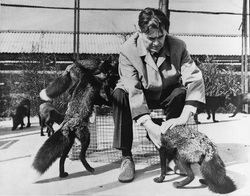 The story of Dmitry Belaraev's long-term experiment in fox domestication was beautifully covered by Scientific American and The Discover Blogs as well as on Radiolab. I found the story and the science behind it fascinating, but I wasn't sure a book was needed to delve further in the story. After I read How to Tame a Fox (and Build a Dog), I learned how wrong I was.
The story of Dmitry Belaraev's long-term experiment in fox domestication was beautifully covered by Scientific American and The Discover Blogs as well as on Radiolab. I found the story and the science behind it fascinating, but I wasn't sure a book was needed to delve further in the story. After I read How to Tame a Fox (and Build a Dog), I learned how wrong I was.Lee Alan Dugatkin co-authored the book with one of the original researchers, Lyudmila Trut. The authors are able to tell the story of Belaraev's seemingly Quixotic plan to tame foxes in a way that is compelling, even when I knew the major plot points.
The project's hypothesis was simple: continuous breeding of the tamest/gentlest foxes would lead to foxes that behaved like dogs. I found it amazing that they were so committed to scientific rigor that they ran a parallel experiment where they chose the most aggressive foxes. At the time, Belaraev faced obstacles from the ruling Communist party. Today, scientists would also question funding such a long-term experiment. Most geneticists use animals with short lifespans (e.g. fruit flies, C. elegans, yeast) so they can get results quickly and at lower costs. The experiment started producing results far earlier than even the principal investigators would have guessed. Even after a few generations, they found that the foxes showed more dog-like traits (floppy ears, tails, and other classic signs of neotony.) After 10 generations, they found that females went into estrus earlier and some male pups showed changes in fur color.
These changes were all predicted by Belaraev, who had a pretty revolutionary idea at the time, which he called "destabilizing selection". He suggested that the changes that occur in the course of domestication aren't simply due to the accumulation of mutations, but rather changes in the expression of existing genes.
 |
| Graphical Abstract from Parker et al Cell Reports 2017 |
Perhaps the most fascinating parts of the book were the details concerning the barriers to science in Soviet-era Russia. These included the domination of genetics by a non-scientist named Trofim Lysenko, who was staunchly opposed to the ideas of Darwin and Mendel; these ideas were gaining acceptance at the time in the West. Lysenko even convinced Lenin that putting seeds in the cold would make crops grow better at low temperatures (they don't). Lysenko fabricated data to support his ideas and those of the party, which devastated Soviet agriculture for decades. Lysenko was celebrated by the Communist party simply for being a peasant and for going against "bourgeois Western science". Interestingly, Khrushchev's daughter Rada, a journalist who trained as a biologist, argued against Lysenkoism and fought to protect science and the work of Belaraev. I think this serves as another example of why it's best to keep politics out of science (but not science out of politics!) The stories of the suppression of science in the height of soviet Russia are evocative of current anti-science rhetoric in these United States.
 One of the reasons that Belaraev was able to persevere in the face of such odds was his enthusiasm and charisma. Belaraev was a social chameleon, who could easily adapt to his audience. These traits made people gravitate towards him and helped him argue for the benefits of the fox experiment to the powers that be. Officially, the rationale of the experiment was to breed foxes that would have more variety in their colors, which would help fetch higher prices for their fur. The domestication experiment was funded despite the crackdown on work in genetics. This isolationism crippled Russian scientists, who were cut off from the science in the rest of the world.
One of the reasons that Belaraev was able to persevere in the face of such odds was his enthusiasm and charisma. Belaraev was a social chameleon, who could easily adapt to his audience. These traits made people gravitate towards him and helped him argue for the benefits of the fox experiment to the powers that be. Officially, the rationale of the experiment was to breed foxes that would have more variety in their colors, which would help fetch higher prices for their fur. The domestication experiment was funded despite the crackdown on work in genetics. This isolationism crippled Russian scientists, who were cut off from the science in the rest of the world.In the late 1980s the fox experiment was 30 years old. The farm started to have some trouble with funding and the researchers had to scale back the experiment. The situation was made worse in 1998 when the Russian economy collapsed. The scientists started sacrificing some of the foxes and selling their pelts. Shortly after this, they contacted a few select media outlets to cover the story, which helped them secure some funding for the project. Today, the experiment has been going on for 60 years, which is a long time for a laboratory experiment, but a short time frame for evolution.
How to Tame a Fox (and Build a Dog) was a fascinating and ultimately hopeful story. Even in such a difficult political climate, this scientist and his visionary experiment were able to persevere with some patience and ingenuity, a message that I think will resonate with scientists that are struggling to stay afloat in 2017.
No comments:
Post a Comment
Note: Only a member of this blog may post a comment.